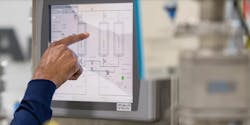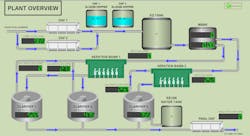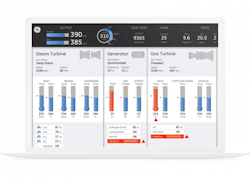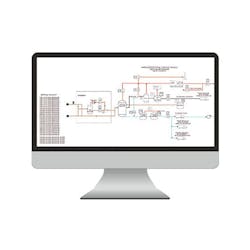HMI & SCADA Amid the Digital Transformation
While both human machine interface (HMI) and supervisory control and data acquisition (SCADA) technologies connect humans with equipment, HMIs tend to be local to a machine, allowing a user to interact directly with equipment or a process, while a SCADA system is often located in a central control room and used to monitor equipment and industrial processes from a distance.
The two technologies, which include both hardware and software, evolved in parallel with the introduction of computers for monitoring and managing industrial processes, beginning in the 1950s. They were developed in response to the growing size of factories and other facilities and the increasing complexity of machines and processes, which made them more difficult for humans to manage manually. Today, both HMI and SCADA are integral to automated systems for industry, infrastructure and facilities.
Operational windows
HMIs serve as the operator window into a machine or industrial control system. It is the hardware and software through which an operator interacts with a controller to view process status and historical information, enabling workers to manage most aspects of machine operation and maintenance. Their purpose is to improve productivity and efficiency, reduce costs, increase reliability and produce safer working environments.
An HMI display can range from a physical control panel with buttons and indicator lights to an industrial PC with a color graphics display running dedicated HMI software. Tablets for portable access to information, touch screen monitors and wearable devices represent a growing share of today’s HMI display market.
HMIs enable human operators to monitor the state of a process under control, modify control settings to change the control objective, and manually override automatic control operations in the event of an emergency. They also allow a control engineer or operator to configure set points or control algorithms and parameters in the controller.
One of the latest trends in the design of HMI screens is called high-performance HMI. It’s based on extensive studies of how humans respond to visual cues and how too many colors or graphic elements on a screen can be confusing.
Working on the theory that less is more, a high-performance HMI screen will be primarily gray with just the devices or systems requiring attention highlighted in any kind of attention-getting color. Proponents of high-performance HMIs say the gray-scale screens with minimal color enable better situational awareness for operators by better directing their response to high priority problems.
Monitor and manage processes
A SCADA system is a combination of hardware and software that enables the automation of industrial processes by capturing data from operating equipment in real time. The system captures data from sensors and other field devices that monitor and manage processes.
A SCADA system enables organizations to:
- Control processes locally or at remote locations
- Acquire, analyze and display real-time data
- Directly interact with industrial equipment such as sensors, valves, pumps and motors
- Record and archive events for future reference or report creation.
SCADA architecture includes computers, networked data communications and graphical user interfaces for high-level supervision of machines and processes. It also incorporates control devices such as remote terminal units (RTUs), programmable logic controllers (PLCs), programmable automation controllers (PACs) or industrial PCs (IPCs) that manage the machines in industrial processes.
The term SCADA was first used in the early 1970s. The increased use of microprocessors and PLCs on the factory floor during that decade made it easier for companies with complex production processes to gather data from their equipment to better monitor and control their automated systems.
The information collected by the SCADA system is utilized to monitor and manage ongoing processes; in this way its performance is similar to that of an HMI, but at a plant-wide or process level. SCADA systems can be found just about everywhere, from factories to infrastructure to facilities.
Distributed control
Another variation on SCADA is a distributed control system, with autonomous controllers distributed throughout a facility and with no central operator supervisory control. A DCS is designed to increase reliability and reduce installation costs by localizing control functions near equipment while maintaining remote monitoring and supervision. DCS systems are designed to manage a process while the priority for SCADA systems is data gathering.
Today the functionality of SCADA and DCS systems is very similar, but DCSs tend to be used in large continuous process plants where high reliability and security are important and the control room is not geographically remote.
Opening platforms
Until recently SCADA systems have nearly all been vendor-specific, which often made integration with hardware and software from other suppliers difficult and expensive. As IT technologies like Ethernet, web-based applications and structured query language (SQL) databases moved into factories, however, this began to change.
As SCADA and HMI technology continues to evolve, the goal is to continue to improve the efficiency, security, productivity and reliability of these systems and the machines and processes they oversee.
Noteworthy HMI/SCADA advances
With HMI and SCADA visualization technology being such a widely used automation technology across the discrete and processing industry verticals, Automation World asked its end user and integrator readers to weigh in on what HMI/SCADA advances over the past decade have been most impactful.
According to end users, the three biggest advances are integrated development environments for HMIs and connected devices, remote HMI apps, and the ability to share screens from HMI to another.
System integrators agreed with remote HMI apps and integrated development environments being among the top advances made over the past decade, but cited wide screen, high-resolution displays as their third choice among the top three advances.
Thirty percent of integrators cited support for popular media formats such as videos, PDFs, and Xcel documents as being a notable advance, yet no end users did the same. Similarly, no end users cited wide-screen, high-resolution displays as notable advance even though 50% of integrators thought so.
High-performance or highly graphical?
Though the term high-performance HMI sounds like a very advanced and possibly complex type of HMI display, it’s the opposite. In contrast to more standard, modern HMI displays, high-performance HMIs, are not very colorful. For example, you won’t see pipes actively filling with blue or green fluid, or flames underneath a tank indicating an active boiler operation. High-performance HMIs are primarily gray with only the devices or systems requiring attention highlighted in any kind of attention-getting color.
Supporters of high-performance HMIs say the gray-scale screens with minimal color enable better situational awareness for operators by better directing their response to high priority problems. Despite this, many industry professionals prefer the more highly graphical type of HMI displays. They like the realism provided by the colorful graphics, and some equipment manufacturers say the more advanced and colorful HMIs allow OEMs to encode help for operators inside the HMIs.
Results from the Automation World survey highlight the ongoing difference of opinion over high-performance and highly graphical HMIs.
According to our end use respondents, only 10% use high-performance HMIs exclusively, whereas 32% use highly graphical HMIs. The bulk of respondents (58%) indicate use of both HMI types.
Integrators, however, note that 56% of clients prefer high-performance HMI screens.
A key factor in this disparity is likely attributable to the industries end user and integrator respondents most represent. End user respondents (52%) were largely from the batch manufacturing industries (such as food and beverage, pharmaceutical), whereas only 23% work in the continuous process industries. Integrator respondents, however, work primarily in the continuous process industries (64%).
Considering the higher level of safety risks in the continuous processing industries, the elevated levels of preference for high-performance HMIs among our integrator respondents makes sense.
Remote access
In line with respondents’ ranking of HMI remote access apps as being among the most beneficial advances in HMI technology over the past decade, 55% of end users say they use remote access HMI apps. Meanwhile, 78% of integrators note use of remote access HMI apps among their clients.
According to integrator respondents, remote HMI access—though widely recognized as being important—is not yet widely used. Seventy-one percent of integrators say 25% or fewer of their client use the technology, while no integrators say that more than 75% of their clients use it.
Among end user respondents, fewer than 20% of respondents would be considered new to remote HMI access app use based on having used it two years or less. According to the survey 52% of end users have been using remote HMI access aps for more than five years.
Though 41% of end users expect to use remote HMI apps in the next two years, 59% do not. This is likely a reflection of the current wide use of remote HMI access apps among end user respondents, i.e., those companies most likely to use remote HMI access apps are already doing so.
As with the difference between high-performance and highly graphical HMI visualization types, the difference in industries most represented by this survey’s end user and integrator respondents is a key factor. The safety and security aspects of continuous process operations likely precludes wide use of remote HMI access apps compared to the batch and discrete manufacturing industries based on end user responses.
Cloud data
One area where the discrete and batch manufacturing industries align with the continuous process industries is in connecting HMI/SCADA systems to the cloud.
Among end users, 74% say their HMI/SCADA technologies are not connected to the cloud. Meanwhile, most integrators (89%) note that less than 25% of their clients connect HMI/SCADA to the cloud.
Both end users and integrators also largely agree on how they use HMI/SCADA cloud connections when they are used. Data analysis was cited as the main purpose of HMI/SCADA cloud connectivity by 100% of end users and 63% of integrators. Remote access to HMI/SCADA data (without direct access to the HMI/SCADA software) was also cited as a primary use of HMI/SCADA cloud connectivity, with 57% of end users and 50% of integrators indicating such use.
Another main use of HMI/SCADA cloud data was for troubleshooting, according to end users. Integrators, however, did not cite use of HMI/SCADA cloud data for troubleshooting, but 37% of integrators did note use of HMI/SCADA cloud data for sharing with other software systems, such as enterprise resource planning (ERP), manufacturing execution systems (MES), and computerized maintenance management systems (CMMS).
HMI/SCADA hardware recommendations
Unsurprisingly, a primary piece of advice from both integrator and end user respondents was to seek out industrial levels of robustness, durability, and reliability in any HMI/SCADA hardware you may be considering. Beyond such obvious features, the recommendations from integrators and end users diverged a bit.
Integrators stressed the need for HMI/SCADA hardware to have in-house supportability. Given the critical nature of HMI/SCADA, easy access to replace components or swap out entire units using in-house engineering/maintenance personnel is key to avoiding long periods of production downtime if there is any failure of the HMI/SCADA device.
A more specific hardware aspect noted by one integrator involved seeking HMI/SCADA hardware with RAM above 16 GB and at least 2.2 GB of memory for graphics support.
Key features recommended by users include:
- Deploying redundant server racks for SCADA, and industrial PCs for HMIs using agnostic hardware devices
- Seeking HMI hardware with support for drivers to connect to a variety of inputs
- Evidence from the manufacturer to support their device’s consistent functionality and long lifetime
- Onboard cybersecurity features
- Support for HTML use
- Platform independence when it comes to which software can be used with it
One end user recommends that remote access to any HMI/SCADA hardware be “carefully scrutinized, as access to a process without physical presence may present a safety risk.”
This user also notes that HMI/SCADA hardware should suit your application. “For example, access to multiple PLCs from a single HMI may not be necessary but could easily get buried as an unnecessary cost when purchasing new equipment,” the user noted.
“Do not forget daylight readability,” stressed another end user. “Also check the onboard electronics for good EMI (electromagnetic interference) and surge withstanding capability, as well as to verify that the device’s power consumption meets your budget. And make sure the connection ports are what you need in your application (Ethernet, serial, USB, other).”
HMI/SCADA software recommendations
As with HMI/SCADA, flexibility and robustness characteristics were cited by end users and integrators alike as key software capabilities.
Reflecting the ease-of-use trend among all automation technology types, integrators also noted support for no-code/low-code operation and visual customization. Along these lines, some integrators also noted the desirability of vendor-neutral graphics engines that allow the HMI/SCADA software to run on any hardware screen, including mobile tablets and generic monitors.
Key HMI/SCADA software features recommended by users include:
- OPC UA and ISA-95 support
- The ability to auto-generate PLC tags
- Comprehensive alarm management support
- Multiple database connectivity capability
“Keep your selection relative to the application,” advises one user. “There are plenty of bells and whistles available in HMI software, but those features may not be needed for the application at hand. Fancy features can be overwhelming to the user and should remain in context with the desired function.”
About the Author
David Greenfield, editor in chief
Editor in Chief

Leaders relevant to this article:





